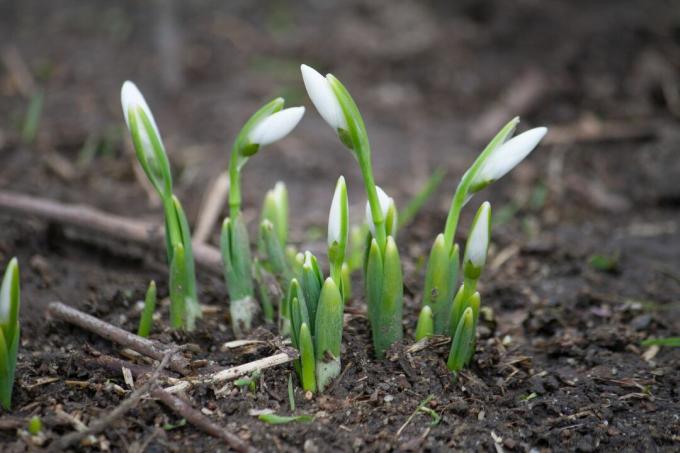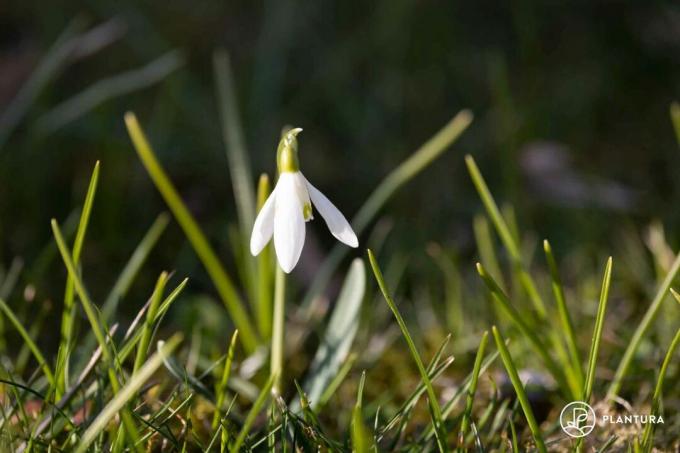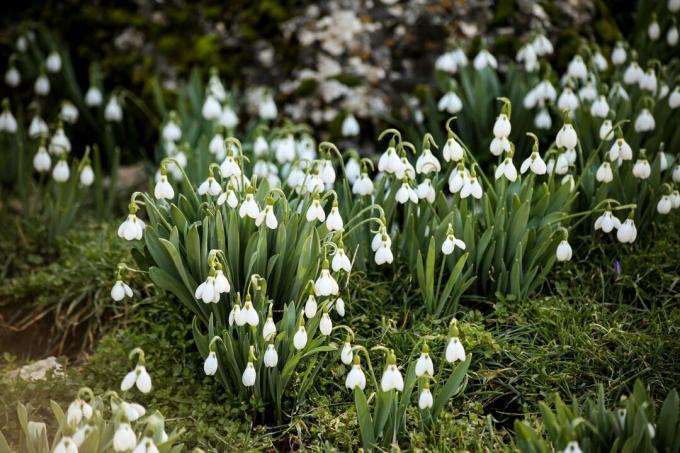It is a real spectacle when the blooming season of the snowdrops begins despite the cold. We'll show you how to plant snowdrops yourself.

Snowdrops (Galanthus) are one of the first to stretch their fresh green from the earth in the New Year. It almost seems as if they are hiding with their slightly hanging white flowers in the last snow, in order to carefully scout out the surroundings for the still sleeping nature. These scouts can also find their way into your house and garden. We have put together everything you need to know so that you can optimally support your snowdrops from the time they are planted.
contents
- Snowdrops: a short profile
- Snowdrop species and varieties
-
Planting snowdrops: location, planting time and procedure
- The right location for snowdrops
- When is snowdrop planting time?
- How to plant snowdrops
- Transplant snowdrops
- Planting snowdrops in the pot
-
Propagate snowdrops themselves
- Sowing snowdrops and pulling them from seeds?
- Propagate snowdrops over daughter onions
- Snowdrops Poisonous or Not?
Snowdrops: a short profile
Everyone longs for a long winter, the moment when the first green leaves emerge from the cold earth and carefully explore the New Year. With their delicate white flowers, snowdrops mark the transition from a winter landscape to a spring meadow. The botanical name is derived from the white petals Galanthus from the Greek words gála for milk and ánthos for blossom. Snowdrops form a genus within the amaryllis family (Amaryllidaceae). The perennial, herbaceous plants have two, rarely three, basal petals and reach heights of up to 35 cm. The single, fragrant flower is on a long stem and hangs slightly.
Snowdrop flowering time
Depending on the species, you can enjoy the delicate white flowers from October to April. Most of these fragile-looking early bloomers break their heads through the layers of snow in January and February. There are only three species like the Queen Olga snowdrops (Galanthus reginae-olgae) that bloom in autumn. Snowdrops are pollinated by insects. Nectar and pollen serve as food for bees, but are spurned as soon as a better source of food is available.

Snowdrop species and varieties
There are a total of 20 different types of snowdrop and around 500 registered varieties. Most of the species are found in the countries around the Black Sea. The species native to us is the little snowdrop (Galanthus nivalis). This species, as well as giant snowdrops (Galanthus elwesii) and Voronov snowdrops (Galanthus woronowii) are most commonly sold in stores as an ornamental plant. The following varieties are particularly beautiful:
- 'Big Boy': very large and massive flowers
- 'Cordelia': double, large flowers
- 'Green Tear': green petals
- 'Wendy's Gold': yellow ovary, large drawing
- 'April Fool': late flowering (April)
- 'Samuel Arnott': robust, vigorous, good for beginners
The different flower colors and shapes show that snowdrops are much more diverse than a white flower on a long stem. If you've caught the snowdrop bug, you can read more about the different ones here Types and varieties of the snowdrop to find out.

Planting snowdrops: location, planting time and procedure
The frugal snowdrop feels so comfortable in the right location that whole clumps of green stems and leaves quickly form over daughter onions. If the bulbs are optimally planted and cared for a little, year after year more snowdrops will herald the transition to spring in your garden.
The right location for snowdrops
If you consider the needs of the onion flower when choosing the location, you will with robust and blooming snowdrops are rewarded, which year after year their way through the earth's crust Find.
- Location: partially shaded to shady
- Soil: rich in humus, loose, water-storing
- Soil pH: alkaline to neutral
Snowdrops can grow alone or with other early bloomers such as crocus (Crocus), Garden cyclamen (Cyclamen) or hyacinths (Hyacinthus) bloom in a flower bed or pot. Its white flowers shine as underplanting for deciduous hedges or perennials between bare branches. Many snowdrops such as the 'Maximus' varieties are well suited for naturalization in the lawn or between ground cover.

Note: Because of the acidic soil conditions, snowdrops don't like a place at the feet of conifers.
When is snowdrop planting time?
It is best to get the onions into the soil in late summer to September. So the first roots can form before the first long frost and the next year the plants will sprout vigorously from the earth. Planting in spring is also possible. Often the onions that are available in specialist shops no longer sprout because they have dried out too much. Instead, you can also buy young plants. These can be planted out at any time. It should just be frost-free.
How to plant snowdrops
Planting snowdrop bulbs, like any gardening, is laborious. However, if you keep the following points in mind when planting snowdrops, your efforts will be rewarded with plenty of blooms the following spring.
- Planting hole: 5 - 8 cm deep
- Plant spacing: 10 - 15 cm
- Onion with the point up into the planting hole
- Fill the planting hole loosely with soil
- Pour on vigorously

There is no need to plant large groups because large clumps quickly form over daughter bulbs. In the case of onions grown in pots, the onion is not completely buried. It should stick out about two centimeters from the ground. Once the onions have moved into their intended place in the garden, the delicate-looking plants can, with a little care, prove how robust they are. They don't even mind frost. You just take a break from growing until it is warmer again.
- Fertilization: Not necessary, a substrate that is too rich in nutrients promotes the leaves and not the flowers
- Watering: always keep moist; Do not let onions dry out in summer
- Trimming withered inflorescences; Do not remove leaves until after they have wilted
Trimming prevents the formation of seeds, which costs the snowdrop a lot of energy. So do not remove the leaves until after they have wilted; nutrients migrate from the leaves to the onion. If the lawn is overgrown, wait until after it has wilted before mowing.
Transplant snowdrops
Snowdrops should be transplanted between February and the end of March. The plants are most resilient when they are in full bloom and with green leaves. The leaves and stems serve as a source of nutrients for the onion. This is why the plants are not cut back when transplanting. If the soil is frost-free, the division is taken in hand and replanted:
- Dig up plants
- Separate onions (daughter onions are used for propagation)
- Dig planting holes at a sufficient distance
- Place the plant in the planting hole
- Pour on vigorously

If necessary, snowdrops can also be transplanted in autumn. The probability of survival is lower, however, because the bulbs are weakened by the flowering life of the flowering period. Pot plants can be transplanted at any time. It should just be frost-free.
Planting snowdrops in the pot
Snowdrops are not only a delight in the bed. They can also be cultivated in pots to announce spring on the balcony or terrace. To ensure that the forest and meadow plants feel comfortable in the pot, the following applies:
- Planter: min. four times as high as the onion
- Drainage layer made of gravel or potsherds at the bottom of the planter
- Planting time: September to November (onions)
- 5 bulbs / planting hole
- Pot with onions in a dark place at 4 ° C until germination
- Keep the soil slightly moist
- From germination outside or another lighter, cool location
- Watering: water well; Always keep the soil slightly moist; no waterlogging
- Fertilization: 1x after flowering
- Clean up withered inflorescences
Pre-grown onions are put into the pots from January to February. The pots are then immediately placed in the place intended for them. The earth in the pot must not freeze completely. In severe frost, the pots should be moved to a cool, frost-free location such as the cellar or gazebo.
Propagate snowdrops themselves
Snowdrops can be propagated by seeds and by dividing the daughter bulbs. So you can expand your white sea of flowers year after year.
Sowing snowdrops and pulling them from seeds?
Except for a few sterile varieties, snowdrops can be propagated from seeds. These are either bought from specialist retailers or harvested yourself. You will receive your own seeds if you refrain from cleaning out withered inflorescences at the end of the flowering period. The seed pods are usually ripe in April and can be harvested. The brown seeds are best sown in a seed tray with a foil cover. The following must be taken into account:
- Store seeds for 4 weeks at -4 to 4 ° C (Cold germ)
- Sow seeds 1 cm deep (dark germinator)
- Soil: moist, humus-rich soil
- ideal location: shady in summer, partially shaded in spring
- Germination time: 4 to 6 weeks
- plant outdoors in autumn
The cold period is needed so that the seeds germinate more evenly and better. Ants help you reproduce naturally via seeds. They spread the snowdrop seeds without your help at all. This type of spread is called myrmecochory. Unfortunately, it can take three to four years for the seedlings to flower.
Propagate snowdrops over daughter onions
If you want to have flowering snowdrops in the following year through your own propagation, you can fall back on the division of the plant. Snowdrops are one of the bulb flowers. The onion consists of thickened bracts. It serves as a persistence organ for winter and reproduction. Many small daughter bulbs are formed, which in turn sprout and bloom, so that dense clumps are formed. This is how you proceed if you divide the clumps and want to plant the daughter bulbs in a new place:
- Onions come out of the ground when the flowers are over and the leaves are still green
- Daughter onions are removed by hand
- Plant the onions again right away
- Flowering next spring

A piece of the base plate of the onion must remain on the daughter onions. This is where the suction root is formed. The onions come straight back into the ground so that they don't dry out. The dug up onions can also be stored in a cool and dry place and then only get into the ground in September. Giant snowdrop (Galanthus elwesii), however, rarely develop side bulbs.
Snowdrops Poisonous or Not?
With snowdrops, the crowd makes the poison. However, the critical dose for this magical limit is not known. When consuming less than three onions, it is usually enough to drink plenty of water. If there is not only increased salivation, abdominal pain, nausea, vomiting and diarrhea, but also to circulatory disorders with sweating and drowsiness, then you should definitely see a doctor walk. These symptoms of poisoning are due to chemical compounds that are present in all narcissus plants (Amaryllidaceae) can be found. Amaryllidacean alkaloids have a cell killing effect and are poisonous for humans and animals. Even so, snowdrops have been used in folk medicine for a very long time. You can find out more about this in our article "Snowdrops: Toxic or Safe?“.
Because snowdrops bloom so early in the year, they are particularly interesting for insects. Further insect-friendly flowers see this article.
